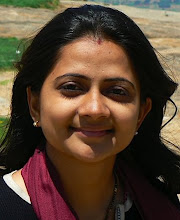
Pashchimottanasana - The seated forward bending.It is compound word in sanskrit. Pashchim means "West" direction as well as back. Uttana means "Stretch". By practicing this asana , stretch and strengthen the spine. This asana is very difficult to practicits known as "Ugrasana" . Ugra means " Shiva". Lord Shiva is believed to be the god of annihilation.
Technique :
- Sit on the floor with the legs stretched straight in front. stretch both the arms out in front and while inhalling raise the arms up all the way above the shoulders.
- bend the trunk forward and hold the feet with the thumbs and the first and middle fingers. Exhale, and bend the trunk lower so that the head rests on the knees.
- If your hands don't reach the toes, you may use a strap looped around the soles of the feet to keep the awareness on the Spine. while using a strap keep the elbows straight. Try to keep the knees straight.
- Draw the abdomen in while bending lower. This will make the bending of the trunk easy. While bending bring the head between the arms. The aspirants having flexible spine can touch the knees with the head at the first attempt.
- Fat persons will find some difficulty in practicing this asana. Person having a weak spine will take a fortnight or a month to perfection in this asana. Remain in this asana for five seconds.
- To come out of the Asana ,stretch the arms out and with an inhalation, begin to straighten the spine up, raising the arms over head . Finally, release the arms while exhaling and rest for couple of breaths.
- Begin with 30 seconds and gradually increase it to 10 minute.
Advantages :
- Pashchimottanasana is very famous of all asana. Its effect is that the life force flows through the sushumna nadi.
- This asana tones liver, spleen, pancreas, adrenal glands and kidneys.
- by practicing this asana we can reduce the excessive fat around the abdomen.
- This asana is properly performed, the spine and each muscle in the back is stretched and suppleness is restored.
- It tones up the intestines, improves digestion,cures constipation, indigestion, liver disorders, dyspepsia, hiccough, gastritis and cures loss of appetite.
- The practice of this asana helps the joints to regain elasticity and rejuvenates the entire spine.
- It has beneficial effect on male prostate and female uterus and eggs. Impotence and sexual weakness are consequently rapidly eliminated.
- Eyes gain a specific magnetism effect.
- This asana is recommended for diabetes and heamorrhoids.
- Unpleasant body odors are gradually disappearing through the practice of this asana. Dermatological disorders are cured.
- Mind becomes stable and calm, the breath calm down.
Contraindication :
This asana is contraindicated for pregnant woman, in case of slipped disc, sciatica, diarrhoea and asthma.




